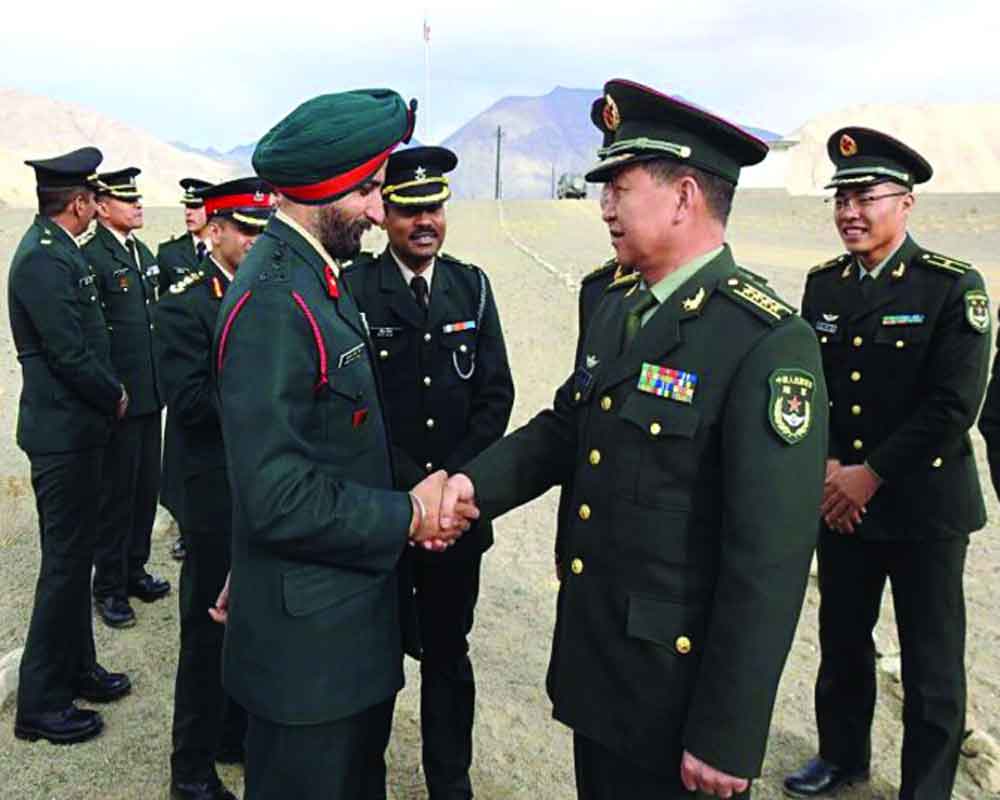The stalemate will continue and about 75,000 Indian troops will continue to occupy the positions along the LAC facing the PLA
There was no breakthrough in the marathon military-level talks between India and China on January 13 with Beijing showing reluctance to complete troop disengagement at a friction point in eastern Ladakh and refusing to discuss steps to diffuse the bigger problems of Depsang and Damchok.
The joint statement stated that “representatives from the defence and foreign affairs establishments of the two sides were present at the meeting” and they had “a frank and in-depth exchange of views for the resolution of the relevant issues” along the LAC in the Western Sector.Both sides “also agreed to consolidate on the previous outcomes and take effective efforts to maintain the security and stability on the ground in the Western Sector including during winter” and to “stay in close contact and maintain dialogue via military and diplomatic channels and work out a mutually acceptable resolution of the remaining issues at the earliest” the statement said.
However, China on January 14 said that it hopes “certain individuals” in India will refrain from making “unconstructive remarks” following Indian army chief General M M Naravane’s remarks that the threat in eastern Ladakh has “by no means reduced” and Indian Army will continue to deal with the Chinese military in a “firm and resolute manner”.
China is unpredictable and is now building a bridge across the Pangong Tso as well as new roads and helipads within its territory in the region for faster troop mobility, as part of its continuing consolidation of military positions facing India amid the 20-month-long confrontation in eastern Ladakh.
The People’s Liberation Army (PLA) is further strengthening its military infrastructure with additional troop shelters, gun positions, helipads and jetties in the area between ‘Finger-8’ and its military bases to the east at Sirijap-I and II on the north bank of the Pangong Lake. The new bridge, in turn, is coming up in the Khurnak Fort area further to the east. The bridge is being constructed, with prefabricated structures, well within Chinese territory. But it will help the PLA move troops and weaponry much faster from the north to the south banks of Pangong Tso and vice versa. China obviously wants to counter India’s quick-reaction capability that saw our soldiers take the Kailash Range heights on the south bank towards end-August 2020.
The LAC runs north to south at Finger-8 in the mountainous spurs region of the brackish 134-km long Pangong Tso, two-thirds of which is controlled by China as it extends from Tibet to India at an altitude of 13,900-feet.
The PLA’s Sirijap complex is around six km east from the LAC at Finger-8, with the Khurnak area being another 20-km beyond it, as per officers who have served in the area. The PLA had captured the Khurnak area in the late-1950s, and then expanded its control westwards to the Sirijap area during the 1962 war.
With India having better connectivity between the two banks of Pangong Tso, China now wants to address the gap. Khurnak is one of the narrowest points of the lake around mid-way during its length. Once the bridge is ready, the PLA can avoid the long loop through Rudok to reach the south bank. It will provide the PLA with an alternate route.
The subsequent troop disengagement in February last year saw Indian soldiers pull back westwards to their Dhan Singh Thapa post between Finger-2 and Finger-3 and vacate the Kailash range heights. PLA troops, in turn, withdrew to their old positions east of Finger-8 to establish a buffer or no-patrol zone in-between.
China had refused to complete the stalled troop disengagement at Patrolling Point-15 in the Hot Springs-Gogra-Kongka La area during the 13th round. The standoff at ChardingNinglung Nallah (CNN) track junction at Demchok and the Depsang Plains is considered even more intractable, as was reported earlier. Consequently, the two armies continue to forward deploy around 50,000 troops each, along with tanks, howitzers and surface-to-air missile systems, for the second consecutive winter along the frontier in the forbidding high-altitude area.
Consequently, after the 14th round of military level talks between the two giants, the stalemate will continue and about 75,000 Indian troops will continue to occupy the positions along the LAC facing the PLA. India has started constructing two-lane roads, bridges and permanent structures all along the LAC so that troops movement, tanks, howitzers and other heavy equipment can move smoothly to thwart any adventure of PLA and also for the sustenance of Indian troops in the extreme cold weather conditions.
(The writer is former Senior Professor, International Trade and Member, Vivekananda International Foundation. The views expressed are personal.)


























